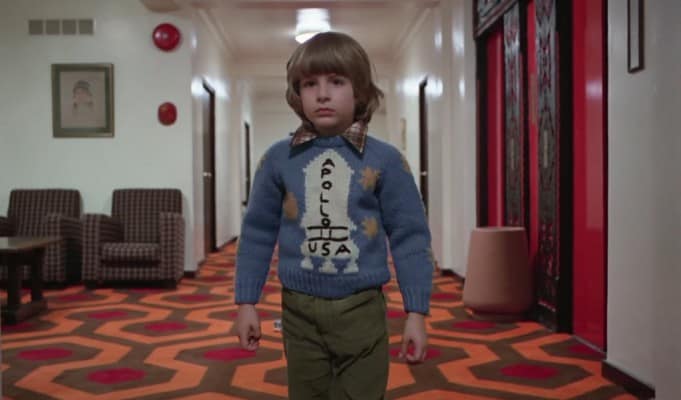
The Shining (1981) is one of the all-time great horror films. I remember reading Steven King’s novel when I was twelve outside on the front porch when my parents were off running errands. I needed to see daylight. I needed to be close to some sort of getaway. Reading that book (and then twice again) was a nerve-wracking, terrifying experience for a young kid. As an adult, though, King’s mastery on those pages, and then Stanley Kubrick’s astounding direction of the film, were high watermarks of not only the genre, but of the creative process.
Kubrick’s realization of The Overlook Hotel was a world that had never been brought to the screen before: expansive hallways, an elevator that oozed oceans of blood, an ominous hedge maze, and, of course, a wickedly over-the-top Jack Nicholson and a petrified mouse in Shelley Duvall.
Enter Room 237, a subjective (indeed) documentary.
Filmmaker Rodney Ascher would have us believe, as revealed through five theorists, that Kubrick (who died in 1999) had more on his mind than just making a film version of King’s novel.
And Kubrick: nice work faking the Apollo moon landing (come on, so obvious that one with Danny wearing the Apollo sweater!)
Normal looking clouds in the Oregon sky during that impressive helicopter pan in the opening shot of The Shining form, in fact, if you closely enough during the few frames right after the last credit rolls off the top, Stanley Kubrick’s face – again, you need to look carefully, and, it may even require a Photoshop overlay to fully reveal the truth.
Oh, also The Shining is really about the holocaust. Why? Because the typewriter that Jack Nicholson so maniacally pounds away on in the lounge is made in Germany.
Aide to Kubrick on ‘Shining’ Scoffs at ‘Room 237’ Theories
“I’m certain that he [Stanley Kubrick] wouldn’t have wanted to listen to about 70, or maybe 80 percent” of “Room 237.”
“Because it’s pure gibberish.”
Last week, the New York Times published a piece (It’s Back. But What Does It Mean?) that refutes the theories as set forth in Room 237. Leon Vitali, personal assistant to Kubrick for The Shining, is quoted several times essentially discounting everything from the minotaur (‘It’s a downhill skier. It’s a downhill skier. It’s not a Minotaur.”) and German typewriter (“That was Stanley’s typewriter”), to Danny’s Apollo sweater (“That was knitted by a friend of Milena Canonero”) and the anti-sementic “Three Little Pigs” (spontaneous on set decision by Nicolson/Kubrick).
In Room 237, a skiing poster in the background in one of the scenes from the film (where Danny first sees the twin girls) is not actually a skiier – it’s a minotaur.
Simple continuity error reveal additional sub-texts and metaphors.
And Kubrick: nice work faking the Apollo moon landing (come on, so obvious that one with Danny wearing the Apollo sweater!)
Ascher makes use of liberal clips from The Shining as each of the five theorists explain via voice-over their various alternative interpretations of the film. What’s fascinating about the presentation is that it gives someone like me–who thinks they’ve already over-analyzed Kurbick to death and already figured out all the hidden meanings film–yet several more points of view. What’s frustrating, though, is the stretch of the imagination and reality required to buy into the deal. By the end of the doc, you have to wonder: who’s crazier, Jack Nicholson with the axe “Here’s Johnnnnny!”, or these conspiracy theorists. To spend this much time analyzing a film frame by frame! Everyone to the maze! Time for a throwdown!
Yet, despite these reservations I found Room 237 quasi-entertaining – in that slightly annoying way when you’re listening to a right-wing extremist or borderline religious psychotic pontificate about life. Fans of The Shining who are seeking out every extra, making of, and insider account of the film production will likely get a kick out of the 100 minute ride.



